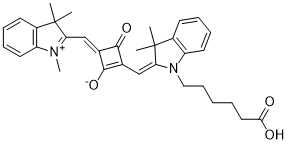867211 | Bromo SquareFluor 631/646, free acid
(E)-2-(((E)-5-bromo-1-(5-carboxypentyl)-3,3-dimethylindolin-2-ylidene)methyl)-3-oxo-4-((1,3,3-trimethyl-3H-indol-1-ium-2-yl)methylene)cyclobut-1-en-1-olate

Please Confirm Your Location
Effective March 1, 2018, Merck KGaA, Darmstadt, Germany* is the exclusive Distributor of Avanti Research. Research Products for all countries except the United States. For product pricing and order placement, please click on the appropriate Location Box below.
For customers located outside the United States, you will be redirected to www.sigmaaldrich.com/avanti prior to completing your purchase. Thank you for your continued business and support of Avanti Research!
*The life science business of Merck KGaA, Darmstadt, Germany operates as MilliporeSigma in the U.S. and Canada
Bromo SquareFluor 631/646, free acid
(E)-2-(((E)-5-bromo-1-(5-carboxypentyl)-3,3-dimethylindolin-2-ylidene)methyl)-3-oxo-4-((1,3,3-trimethyl-3H-indol-1-ium-2-yl)methylene)cyclobut-1-en-1-olate
Squaraine probes are defined by their unique squaric acid derived aromatic ring which leaves the probe vulnerable to nucleophilic attack which destroys its fluorescent ability. This glaring issue has prevented these probes from being studied as much as other probes, but recent advancements in these probe’s synthetic design has helped overcome these shortcomings and brought them to the forefront of fluorescent imaging. Squaraines are known to have extremely intense absorption bands and good photoconductivity while maintaining incredible photostability and a good quantum yield. Another key factor that makes Squaraines probes useful is that they can be synthesized with specific functional groups that target specific biomolecules without compromising the photophysical properties. These properties make these probes promising in photodynamic therapy, bioimaging, and trace analyte sensors.
| C33H35BrN2O4 |
CAS Registry Number is a Registered Trademark of the American Chemical Society

